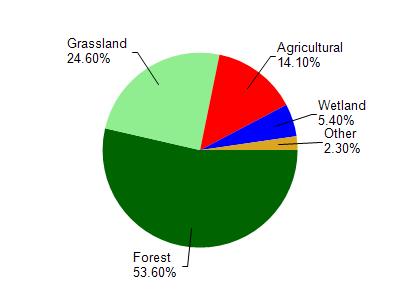Iowa
No
No
No
Fish and Aquatic Life
Overview
Narveson Creek, a tributary to Otter Creek, is a spring fed Class II trout fishery. The stream has been impacted by the construction of a flood control structure. The stream is also affected by nonpoint source pollution from surrounding agricultural land use.
From: Ripp, Coreen, Koperski, Cindy and Folstad, Jason. 2002. The State of the Lower Wisconsin River Basin. PUBL WT-559-2002. Wisconsin Department of Natural Resources, Madison, WI.
Date 2002
Author Cynthia Koperski
Historical Description
Narveson Creek - Mouth location T6N R2E Section 52, Surface area = 1.9 acres Length = 2.4 miles, Gradient = 50.0 feet per mile, Total alkalinity = 251.0 mg/l, Volume of flow = 1.4 cfs.
Narveson Creek is spring fed and enters the upper section of Otter Creek as one of its principal tributaries. About 80 percent of its direct drainage area is cleared for agricultural purposes which along with its fairly steep gradient has resulted in severe flooding and bank erosion. Several small flood control structures have been built by farmers to alleviate flooding. This stream is included in the Otter Creek Watershed Project which proposes to impound it to create a lake for flood control and recreational purposes. Brown trout stocked annually grow well and provide enjoyable fishing. Seining surveys show that forage fish species include bluntnose and stoneroller minnows; hornyhead and creek chubs; common shiners, redbelly dace, white suckers, and johnny darters. Aquatic game assets are limited because of the well-drained nature of the watershed but some muskrats are present in the larger sections. There are no public lands on this stream but it can be reached from three town road crossings.
From: Piening, Ronald and Threinen, C.W., 1968. Lake and Stream Classification Project. Surface Water Resources of Iowa County. Wisconsin Department of Natural Resources, Madison, WI
Date 1968
Author Surface Water Inventory Of Wisconsin
General Condition
Narveson Creek (WBIC 1239100) from its mouth to Blackhawk Lake spillway was assessed during the 2018 listing cycle; new biological (fish Index of Biotic Integrity (IBI) scores) sample data were clearly below the 2018 WisCALM listing thresholds for the Fish and Aquatic Life use. This water was meeting this designated use and was not considered impaired.
Date 2017
Author Ashley Beranek
Condition
Wisconsin has over 84,000 miles of streams, 15,000 lakes and milllions of acres of wetlands. Assessing the condition of this vast amount of water is challenging. The state's water monitoring program uses a media-based, cross-program approach to analyze water condition. An updated monitoring strategy (2015-2020) is now available. Compliance with Clean Water Act fishable, swimmable standards are located in the Executive Summary of Water Condition in 2018. See also the 'monitoring and projects' tab.
Reports
Management Goals
Wisconsin's Water Quality Standards provide qualitative and quantitative goals for waters that are protective of Fishable, Swimmable conditions [Learn more]. Waters that do not meet water quality standards are considered impaired and restoration actions are planned and carried out until the water is once again fishable and swimmable
Management goals can include creation or implementation of a Total Maximum Daily Load analysis, a Nine Key Element Plan, or other restoration work, education and outreach and more. If specific recommendations exist for this water, they will be displayed below online.
Monitoring
Monitoring the condition of a river, stream, or lake includes gathering physical, chemical, biological, and habitat data. Comprehensive studies often gather all these parameters in great detail, while lighter assessment events will involve sampling physical, chemical and biological data such as macroinvertebrates. Aquatic macroinvertebrates and fish communities integrate watershed or catchment condition, providing great insight into overall ecosystem health. Chemical and habitat parameters tell researchers more about human induced problems including contaminated runoff, point source dischargers, or habitat issues that foster or limit the potential of aquatic communities to thrive in a given area. Wisconsin's Water Monitoring Strategy was recenty updated.
Grants and Management Projects
Monitoring Projects
| WBIC | Official Waterbody Name | Station ID | Station Name | Earliest Fieldwork Date | Latest Fieldwork Date | View Station | View Data |
|---|
| 1239100 | Narveson Creek | 10012291 | Narveson Creek - Entrance To Blackhawk Lake | 5/1/2006 | 7/25/2006 | Map | Data |
|

Watershed Characteristics
Narveson Creek is located in the Otter and Morrey Creeks watershed which is 198.69 mi². Land use in the watershed is primarily forest (53.60%), grassland (24.60%) and a mix of agricultural (14.10%) and other uses (7.70%). This watershed has 437.57 stream miles, 351.55 lake acres and 5,785.74 wetland acres.
Nonpoint Source Characteristics
This watershed is ranked Not Ranked for runoff impacts on streams, Low for runoff impacts on lakes and High for runoff impacts on groundwater and therefore has an overall rank of High. This value can be used in ranking the watershed or individual waterbodies for grant funding under state and county programs.However, all waters are affected by diffuse pollutant sources regardless of initial water quality. Applications for specific runoff projects under state or county grant programs may be pursued. For more information, go to surface water program grants.